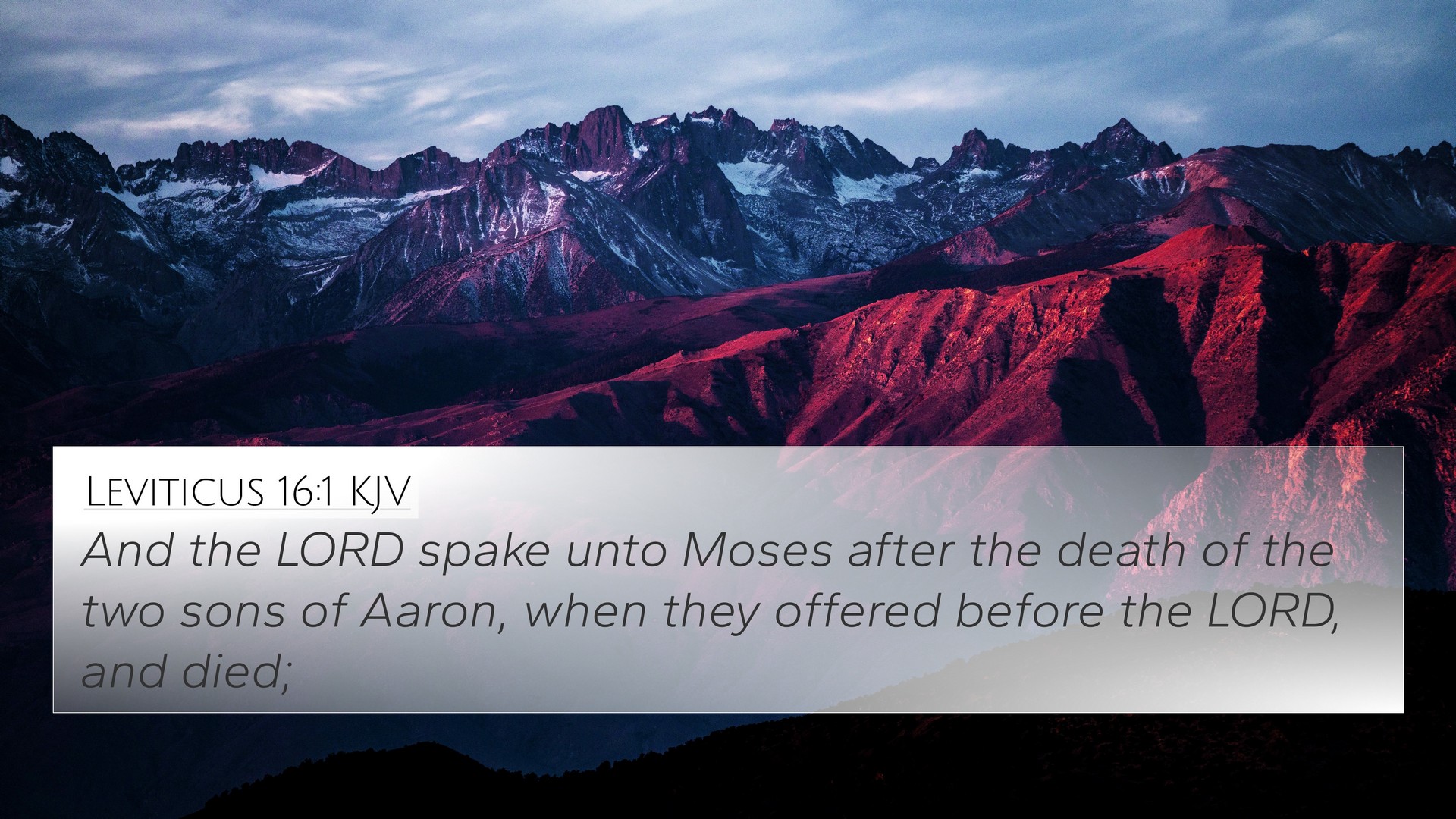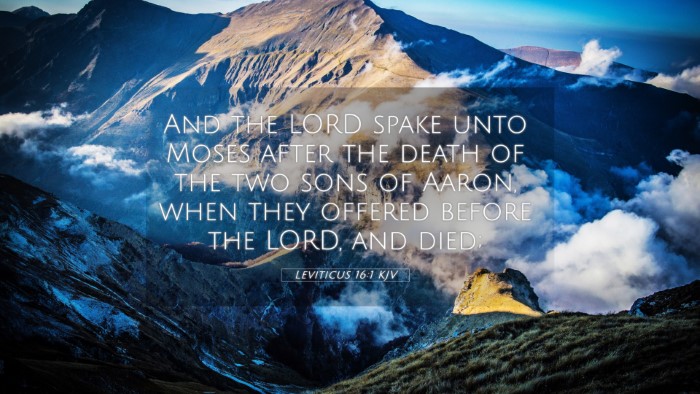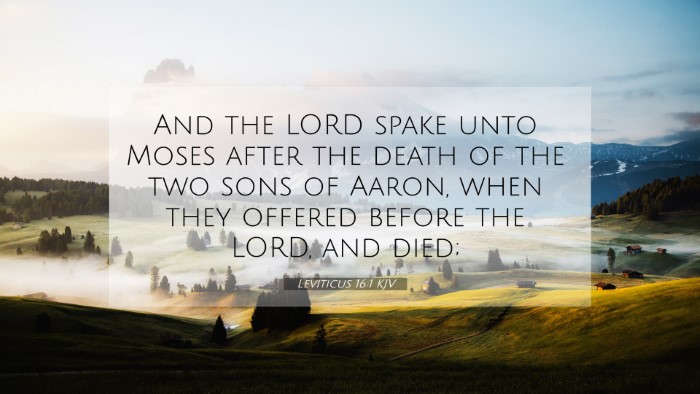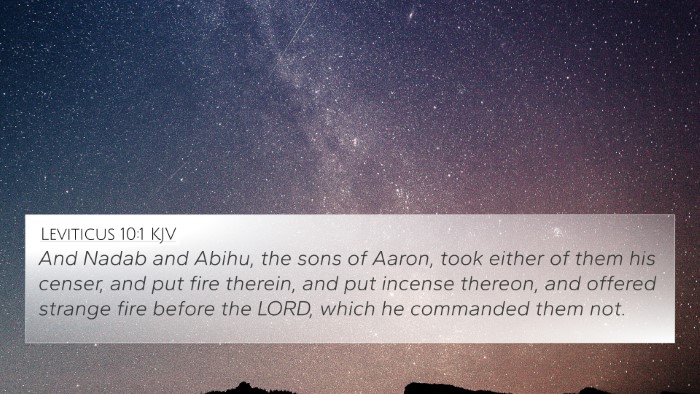Understanding Leviticus 16:1
Leviticus 16:1 serves a pivotal role in the narrative of the Day of Atonement, highlighting the significance of this sacred observance in the life of Israel. It provides insight into God’s instructions concerning access to His presence, particularly in relation to the high priest’s actions and the requirements therein.
This verse reads: "And the LORD spake unto Moses after the death of the two sons of Aaron, when they offered before the LORD, and died."
Exegesis and Context
In exploring the context of Leviticus 16:1, we must consider several factors:
-
Divine Communication: The verse emphasizes that God speaks directly to Moses, signaling the continued guidance and direct communication from God to His people through Moses.
-
Death of Aaron's Sons: The reference to the deaths of Nadab and Abihu underscores the seriousness of approaching God's holiness. Their unauthorized offering serves as a warning regarding the sanctity of divine instructions (Leviticus 10:1-3).
-
Preparation for Atonement: This verse precedes the detailed instructions about the Day of Atonement, indicating the need for proper preparation and reverence before God.
Commentary Insights
Matthew Henry's Commentary
According to Matthew Henry, this verse serves as a pivotal transitional moment. He notes that it is essential to understand the gravity of the situation following the tragic events involving Aaron's sons. Henry highlights that God’s instructions reflect His mercy and the need for atonement among His people.
Albert Barnes' Notes
Albert Barnes elaborates on the notion that God’s reprimands came with further revelation. He explains how the deaths represent a significant event that prompted the establishment of the Day of Atonement. Barnes points out that this is a demonstration of God’s holiness in juxtaposition with human fallibility.
Adam Clarke's Commentary
Adam Clarke notes the divine command following a moment of divine judgment, illustrating God's control over priestly conduct. Clarke elaborates on how this instruction highlights the importance of atonement and the role of the high priest during these sacred observances. He emphasizes the necessary sacrifices needed to restore the covenant relationship with God.
Key Themes and Cross-References
Leviticus 16:1 serves as a foundational verse in understanding several key biblical themes, including sacrifice, atonement, and holiness. Here are some relevant cross-references:
- Hebrews 9:7: Discusses the high priest’s sacrifice for his own sins before the sins of the people.
- Leviticus 10:1-3: Chronicles the account of Nadab and Abihu’s offering, serving as a cautionary tale for approaching God.
- Exodus 29:43-46: Relates God’s presence dwelling among the people, emphasizing His holiness.
- Hebrews 4:14-16: Provides insight into the significance of Christ as our high priest, linking the Old Testament to the New.
- Romans 3:25: Mentions Christ as a propitiation for sins, parallel to the atonement themes in Leviticus.
- 1 Peter 1:15-16: Urges believers to be holy, as God is holy, reinforcing the moral standard derived from Leviticus.
- Leviticus 16:8-10: Gives detailed practices of the two goats, one for the Lord and the other as the scapegoat, revealing deeper atonement principles.
- Isaiah 53:5: Prophecies of Christ’s sacrifice provide New Testament connections to atonement themes in Leviticus.
- John 1:29: Proclaims Jesus as the "Lamb of God," establishing continuity in sacrificial theology.
- Matthew 27:51: Describes the tearing of the temple veil, highlighting the removal of barriers to God through Christ’s atoning work.
Conclusion
Leviticus 16:1 serves not only as an introduction to the Day of Atonement but also as a reminder of the need for holiness and reverence when approaching God. The insights derived from the public domain commentaries enhance our understanding of this pivotal verse and illustrate its thematic connections throughout the Bible. As we explore the surrounding texts and their implications for both the Old and New Testament, we uncover rich layers of theological significance.
The verse invites readers to consider the gravity of sin, the holiness of God, and the provision of atonement through Christ, fulfilling the sacrificial system established in the Old Testament. Through cross-referencing Biblical texts, we can navigate the connections between various scriptural themes, enriching our study, comprehension, and application of the scriptures in our lives.



